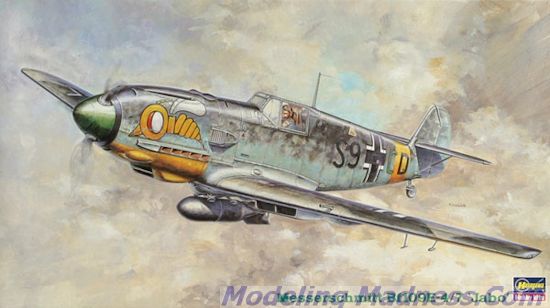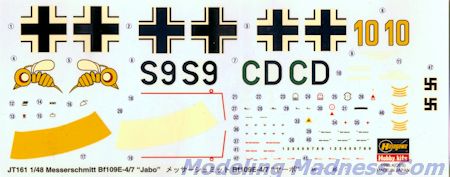
Hasegawa 1/48 Bf-109E-4/7 "Jabo"
|
KIT # |
09261 |
|
PRICE: |
2200 yen |
|
DECALS: |
Two versions |
|
REVIEW & |
|
|
NOTES: |
1998 boxing |

|
HISTORY |
The Bf-109E-7 was the last major version of the E to be produced, entering service and seeing combat at the end of August 1940. One of the limitations of the earlier Bf 109E was their short range of 660 km (410 mi) and limited endurance, as the design was originally conceived as a short-range interceptor. The E-7 rectified this problem as it was the first subtype to be able to carry a drop tank, usually a 300 L (80 US gal) capacity unit mounted on a rack under the fuselage, which increased their range to 1,325 km (820 mi). Alternatively, a bomb could be fitted and the E-7 could be used as a Jabo fighter-bomber. Previous Emil subtypes were progressively retrofitted with the necessary fittings for carrying a drop tank from October 1940. Early E-7s were fitted with the 1,100 PS DB 601A or 1,175 PS DB 601Aa engine, while late-production ones received 1,175 PS DB 601N engines with improved altitude performance – the latter was designated as E-7/N. A total of 438 E-7s of all variants were built.
|
THE KIT |
The initial boxing of this kit, in the J series (as opposed to the Jt
series and later) had some glitches. Apparently the rear fuselage was a bit too thin and the
forward part of the upper cowling was not exactly right. If I recall, Tamiya
glitched the upper cowling as well.
It seems that these problems were ones that could be fixed by shaving material
from the mold so Hasegawa went back and corrected the flaws after boxing about a
half dozen versions of this kit. In other words, don't buy the initial J series
of kits if you are concerned about this.
In line with other limited edition boxings, this kit includes the
standard instruction sheet and provides an addendum sheet to take care of the
bits not covered in the other sheet (usually markings). In this case, there are
two options. One is the wasp-nosed version from III./SKG 210 in RLM 74/75/76
with a green 
 spinner
and rather heavy fuselage mottling. The lower cowling is painted yellow and
there is a yellow fuselage band and wing tips. The other aircraft is in the same
scheme with a yellow nose and yellow rudder with a white fuselage band. The
mottling on this one is not as heavy. This aircraft was with III./JG 27. The
spinner has fine yellow bands that are provided as decals. These are the 'old
school' decals so are a bit thick and with white that is off white. I'd
recommend painting the fuselage bands.
spinner
and rather heavy fuselage mottling. The lower cowling is painted yellow and
there is a yellow fuselage band and wing tips. The other aircraft is in the same
scheme with a yellow nose and yellow rudder with a white fuselage band. The
mottling on this one is not as heavy. This aircraft was with III./JG 27. The
spinner has fine yellow bands that are provided as decals. These are the 'old
school' decals so are a bit thick and with white that is off white. I'd
recommend painting the fuselage bands.
|
CONCLUSIONS |
Despite the newer kits that have been produced of the 109E in this
scale, this kit is still a popular favorite among builders. There is a lot of
aftermarket available for it so those who want the additional detail can have
it. Out of the box it is still a very nice model and holds up well despite its
25 year old molding technology.
REFERENCES
http://en.wikipedia.org/wiki/Messerschmitt_Bf_109_variants September 2014 Review kit courtesy of my kit collection. If you would like your product reviewed fairly and
fairly quickly, please contact
the editor or see other details in the
Note to
Contributors.